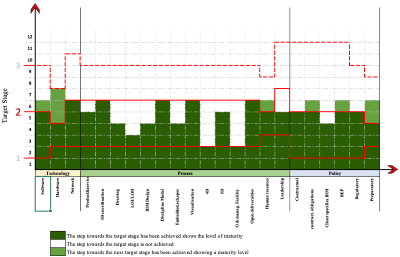Penerapan Evaluasi Building Information Modelling Maturity di salah satu Kontraktor BUMN Indonesia
DOI:
https://doi.org/10.24036/cived.v10i2.426Keywords:
Building Information Modelling; Maturity; Fase konstruksi; Infrastruktur; Self-assessment.Abstract
Kajian ini bertujuan untuk mengevaluasi sekaligus mendalami tingkat kematangan implementasi BIM pada suatu organisasi yang mengelola proyek infrastruktur. Pengumpulan data diperoleh dari 19 proyek infrastruktur di salah satu BUMN karya di Indonesia yang memiliki karakteristik berbeda melalui kuesioner self assessment terhadap kondisi penggunaan BIM di masing-masing proyek. Penilaian difokuskan pada rangkaian kompetensi BIM, kapabilitas BIM, dan skala organisasi yang hasilnya berupa grade implementasi BIM. Hasil penelitian menunjukkan bahwa jika hanya satu proyek yang mendapatkan penilaian maksimal atau termasuk dalam kategori kematangan optimis atau tinggi, maka 42,1% proyek berada pada kategori kematangan terintegrasi atau sedang-tinggi dan 52,6% berada pada tingkat kematangan yang dikelola atau sedang. Kesimpulannya, secara organisasi implementasi BIM yang terjadi berada pada level managed atau medium maturity. Diagram visual kapabilitas dan maturitas BIM disajikan dengan banyak celah yang terjadi dalam kumpulan kompetensi proses seperti produk & layanan, gambar, LOI/LOD, desain BIM, spesifikasi jadwal tersemat, 4D, 5D, manajemen operasi & fasilitas, dan kepemimpinan. Temuan ini menjadi acuan bagi pemangku kepentingan untuk menentukan langkah dan strategi perbaikan dan pengembangan ke depan.
Downloads
References
AGC (2006). “The Contractors’ Guide to BIM, The Associated General Contractors of America”, availableat:www.ipdca.net/images/Integrated%20Project%20Delivery%20Definition.pdf (accessed 1 February 2023).
Andrade HL. (2019). “A Critical Review of Research on Student Self-Assessment”. Front. Educ. 4:87. DOI: 10.3389/feduc.2019.00087.
Ashcraft, H.W. (2008). Building information modeling: a framework for collaboration, Construction Lawyer, Vol. 28 No. 3, pp. 1-14.
Card, S.K. & Mackinlay, J. (1997). “The structure of the information visualization design space”, IEEE Symposium on Information Visualization, Phoenix, AZ, USA, vol. 125, pp. 92-99.
Ding, L., Zhou, Y. & Akinci, B. (2014). “Building Information Modeling (BIM) application framework: the process of expanding from 3D to computable nD”, Autom. Constr. 46, pp. 82-93.
Dodge Data & Analytics. (2017). “SmartMarket Report the Business Value of BIM for Infrastructure”, pp. 1–68.
Eastman, C., Teicholz, P., Sacks, R., & Liston, K. (2011). “A Guide to Building Information Modeling for Owners, Managers, Designers, Engineers, and Contractors”.
Fergus I. M. Craik & Robert S. L. (1972). “Levels of Processing: A Framework for Memory Research”, Journal of verbal learning and verbal behavior 11, 671-684.
Fitzpatrick, B. & Schulz, H. (2016). “Teaching young students to self-assess critically”, Paper presented at the Annual Meeting of the American Educational Research Association (Washington, DC).
Gilligan, B. & Kunz, J. (2007). “VDC Use in 2007: Significant Value, Dramatic Growth, and Apparent Business Opportunity, Technical Report, Center for Integrated Facility Engineering, Stanford University”, Stanford, CA, 4 December.
Hutchinson, A. & Finnemore, M. (1999). “Standardized process improvement for construction enterprises”, Total Qual. Manag. 10, pp. 576–583.
Kitsantas, A., & Zimmerman, B. J. (2006). “Enhancing self-regulation of practice: the influence of graphing and self-evaluative standards. Metacogn”. Learn. 1, pp. 201–212. DOI: 10.1007/s11409-006-9000-7.
Lee, A., Wu, S., Marshall-Ponting, A.J., Aouad, G., Cooper, R., Koh, I., Fu, C., Betts, M., Kagioglou, M. & Fischer, M. (2003). “Developing a Vision of nD-Enabled Construction, University of Salford”, Salford.
Lockamy, A. & McCormack, K. (2004). “The development of a supply chain management process maturity model using the concepts of business process orientation”, Supply Chain Management: An International Journal, Vol. 9 No. 4, pp. 272-278.
Mayouf, M., Gerges, M., & Cox, S. (2018). “5D BIM: an investigation into the integration of quantity surveyors within the BIM process”, Journal of Engineering, Design and Technology 13 (3) pp. 537-553.
Mesároš, P., Smetanková, J. & Mandičák, T. (2019). “The fifth dimension of BIM–implementation survey”, IOP Conference Series: Earth and Environmental Science 222.
McGraw-Hill (2009). “SmartMarket Report – The Business Value of BIM: Getting Building Information Modeling to the Bottom Line”, available at: www.bim.construction.com/ research/ (accessed 28 January 2021).
National Institute of Building Sciences. (2012). “National BIM Standard - United States Version 2”, NIBS, United States of America.
Oktem, S., Ergen, E. & Akcamete, A. (2018). “BIM Implementation in Infrastructure Projects: Benefits and challenges”, 5 th International Project and Construction Management Conference (IPCMC2018).
Othman, I., Al-Ashmore, Y.Y., Rahmawati, Y., Amran, Y.H.M. & Al-Bared, M.A.M. (2021). “The level of Building Information Modelling (BIM) Implementation in Malaysia”, Ain Shams Engineering Journal 12, pp. 455-463.
Panadero, E., & Romero, M. (2014). “To rubric or not to rubric? The effects of self-assessment on self-regulation, performance, and self-efficacy”, Assess. Educ. 21, pp. 133–148. DOI: 10.1080/0969594X.2013.877872.
Penttilä, H. (2006). “Describing the Changes in Architectural Information Technology To Understand Design Complexity And Free-Form Architectural Expression”, ITcon, 11(Special Issue the Effects of CAD on Building Form and Design Quality), pp.395-408.
Samimpay, R. & Saghatforoush, E. (2020). “Benefits of Implementing Building Information Modeling (BIM) in Infrastructure Projects”, Journal of Engineering, Project, and Production Management, 10(2), pp. 123-140.
Sampaio A.Z., Novais J.N. & Oliveira J.P. (2019). “Analysis of BIM Implementation in Structural Projects”, 1st Congress of Numerical Methods in Engineering, 1st to 3rd July 2019, University of Minho, Guimarães, Portugal.
Succar, B. (2009). “Building information modeling framework: A research and delivery foundation for industry stakeholders”, Automation in Construction, 18(3), pp. 357-375.
Succar, B. (2010). “Building information modeling maturity matrix, Handbook of Research on Building Information Modeling and Construction Informatics: Concepts and Technologies”, Information Science Publishing, Hershey, PA, pp. 65-103.
Tejeiro, R. A., Gomez-Vallecillo, J. L., Romero, A. F., Pelegrina, M., Wallace, A., & Emberley, E. (2012). “Summative self-assessment in higher education: implications of its counting towards the final mark”, Electron. J. Res. Educ. Psychol. 10, pp. 789–812.
Vaidyanathan, K. & Howell, G. (2007). “Construction supply chain maturity model – conceptual framework”, Proceedings of the International Group for Lean Construction, Lansing, MI, USA, pp. 170-180.
Yang, J.B. & Chou, H.Y. (2019). “Subjective benefit evaluation model for immature BIM-enabled stakeholders”, Automation in Construction 106.
Yilmaz, G., Akcamete, A. & Demirors, O. (2019). “A reference model for BIM capability assessments”, Automation in Construction 101, pp. 245-263.

Downloads
Published
How to Cite
Issue
Section
License
Copyright (c) 2023 Wisnu Kurnia Praja, Jati Utomo Dwi Hatmoko, Ferry Hermawan

This work is licensed under a Creative Commons Attribution 4.0 International License.







2.jpg)
